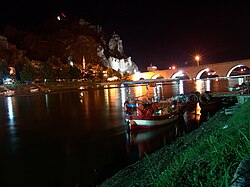Osmancık
This article needs additional citations for verification. (December 2009) |
Osmancık | |
|---|---|
Town | |
 Koyunbaba Bridge | |
 Location of Osmancık within Turkey. | |
 Osmancık Location of Osmancık within Turkey. | |
| Coordinates: 40°58′N 34°48′E / 40.967°N 34.800°ECoordinates: 40°58′N 34°48′E / 40.967°N 34.800°E | |
| Country | |
| Region | Black Sea |
| Province | Çorum |
| Government | |
| • Mayor | Ahmet Gelgör () |
| Area | |
| • District | 1,116.26 km2 (430.99 sq mi) |
| Population (2012)[2] | |
| • Urban | 27,355 |
| • District | 44,363 |
| • District density | 40/km2 (100/sq mi) |
| Time zone | UTC+2 (EET) |
| • Summer (DST) | UTC+3 (EEST) |
| Postal code | 19500 |
| Area code(s) | 364 |
| Vehicle registration | 19 |
| Climate | Cfb[3] |
| Website | www |
Osmancık is a district of Çorum Province in the Black Sea region of Turkey, located 59 km north of the city of Çorum.
Geography[]
Located on an important crossing of the River Kızılırmak on the ancient Silk Road to the orient, Osmancık has long had a strategic value, and is still today a popular stopping-place on the road from Istanbul to the Black Sea city of Samsun and further east.
Today, Osmancık is known for its rice production, being especially suitable for a new strain of rice developed especially for the region by the Turkish Ministry of Agriculture and named "Osmancık-97."
The North Anatolian Fault zone runs through the valley, making Osmancık very vulnerable to earthquakes.

List of neighborhoods[]
- Yazi
- Esentepe
- Gürleyik
- Yeşilçatma
- Cumhuriyet
- Yeni
- Gemici
- Hidirlik
- Kizilirmak
- Güney
- Şenyurt
- Koyunbaba
- Çay
- Çiftlikler
- Eymür
- Karapinar
- Temence
- Ulucamii
History[]
The area was settled by the Kayı clan of the Oghuz Turks as they migrated westwards into Anatolia from their heartland of Central Asia. Osmancık was one of the important destination points in the Ottoman period. Because of a number of earthquakes the city could not keep its ancient architecture. In the last century, there have been 4-5 heavy earthquakes. Being on the path of the Kızılırmak made the city an important settlement point since early history. Osmancık was known as Pimolisa during Roman and Byzantine eras.
Population[]
| Population by year | |||
|---|---|---|---|
| Years | Central | Villages | Total |
| 2008 | 24,678 | 26,486 | 51,164 |
| 2000 | 30,423 | 25,335 | 53,758 |
| 1990 | 21,347 | 31,143 | 52,490 |
| 1980 | 63,018 | ||
| 1970 | 53,849 | ||
| 1960 | 42,960 | ||
| 1950 | |||
| 1927 | 29,184 | ||
| 1907 | 29,473 | ||
| 1893 | 17,639 | ||
| 1831 | 4,349 | ||
Notable natives[]
- Osmancıklı İmamzade Halil Pasha, 15th-century Ottoman statesman, in the court of Mehmed I
- Osmancıklı (Amasyalı) Koca Mehmed Nizamüddin Pasha, 15th-century Ottoman statesman
- Pakçemüezzin Baltacı Mehmet Pasha, 18th-century Ottoman statesman, rumored to have been a lover of Catherine I of Russia
- General Ahmet Çörekçi, Former Head Commander of Turkish Air Force
- Gürkan Coşkun a.k.a. "Komet" - Famous Turkish artist
- Bilal Kısa, Turkish football player, still playing for Galatasaray SK
Places of interest[]
- In the village of Ardıç, to the west of Osmancık, there is a road cut by the Ancient Romans through a rock named Çalınkaya
- Koyunbaba Bridge over the Kızılırmak, built in 1489
- The Seljuk Turk castle of Kandiber, in the town center
- The Ottoman period tomb of Sufi mystic Koyunbaba
- The Trojan war hero Achilles was said to have been finally buried on the hill of Adatepe
External links[]
- District governor's official website
- District municipality's official website
- Osmancikgundem.com - City News Portal
- Osmancık Haber - Weekly Local Newspaper
- Osmancık - Weekly Local Newspaper
References[]
- ^ "Area of regions (including lakes), km²". Regional Statistics Database. Turkish Statistical Institute. 2002. Retrieved 2013-03-05.
- ^ "Population of province/district centers and towns/villages by districts - 2012". Address Based Population Registration System (ABPRS) Database. Turkish Statistical Institute. Retrieved 2013-02-27.
- ^ Osmancık Climate-Data.org
- Osmancık
- Populated places in Çorum Province
- Districts of Çorum Province

